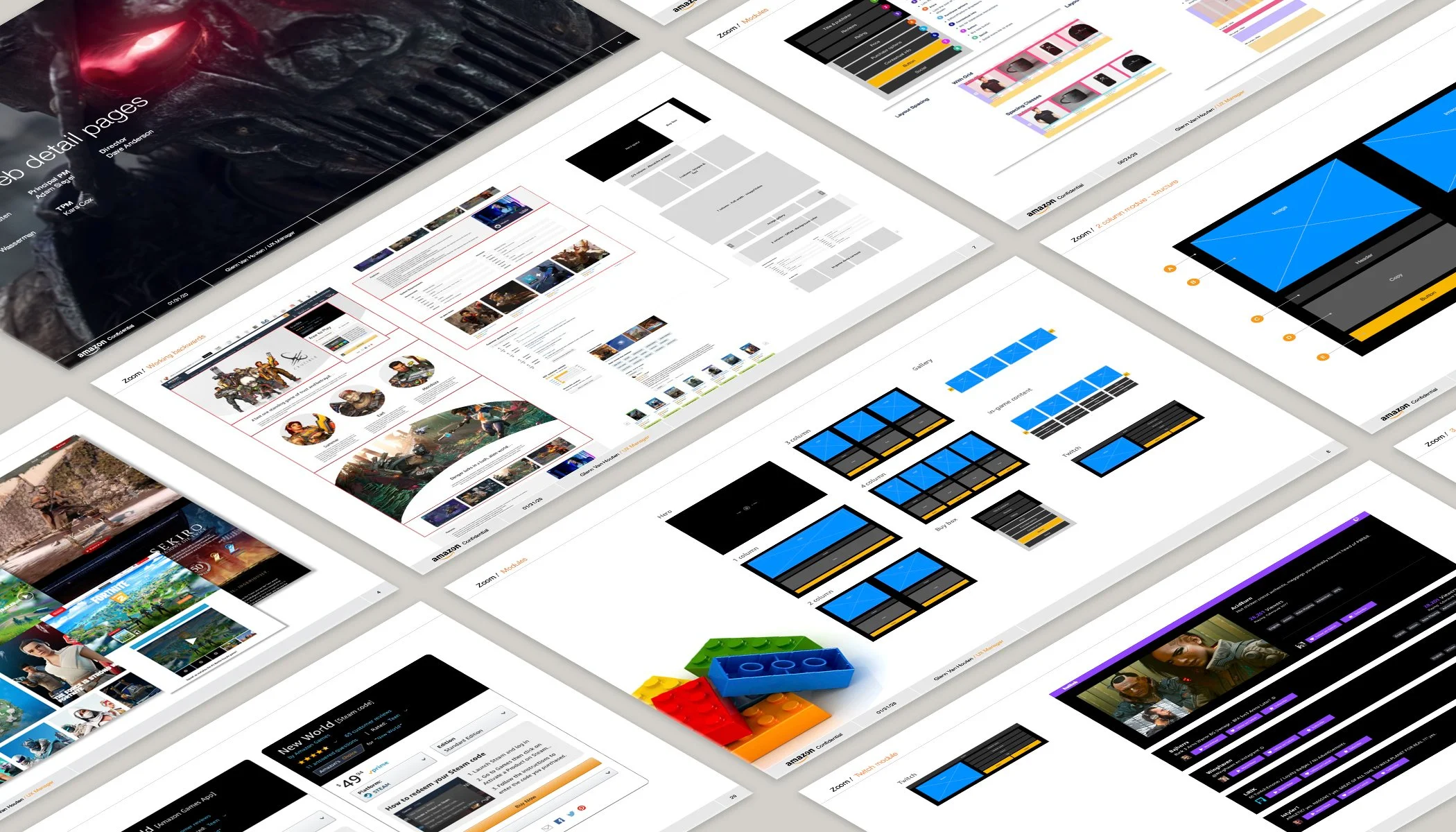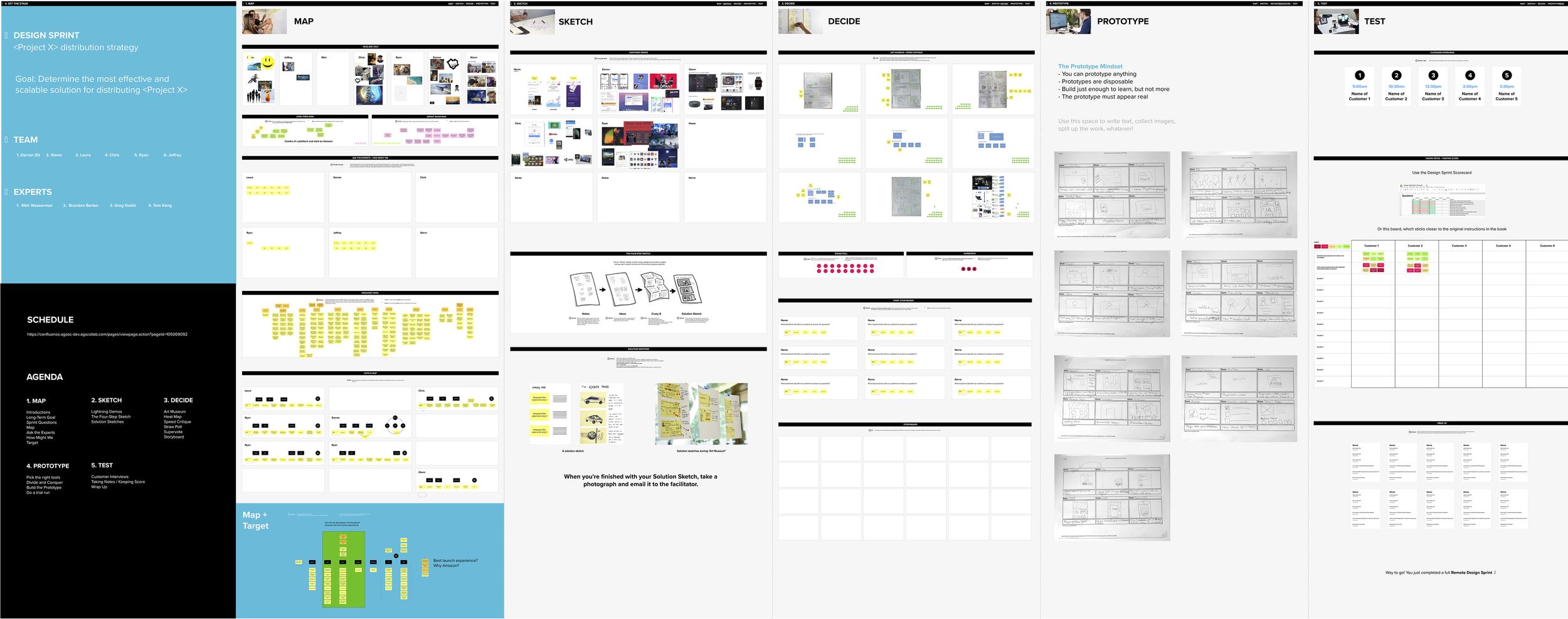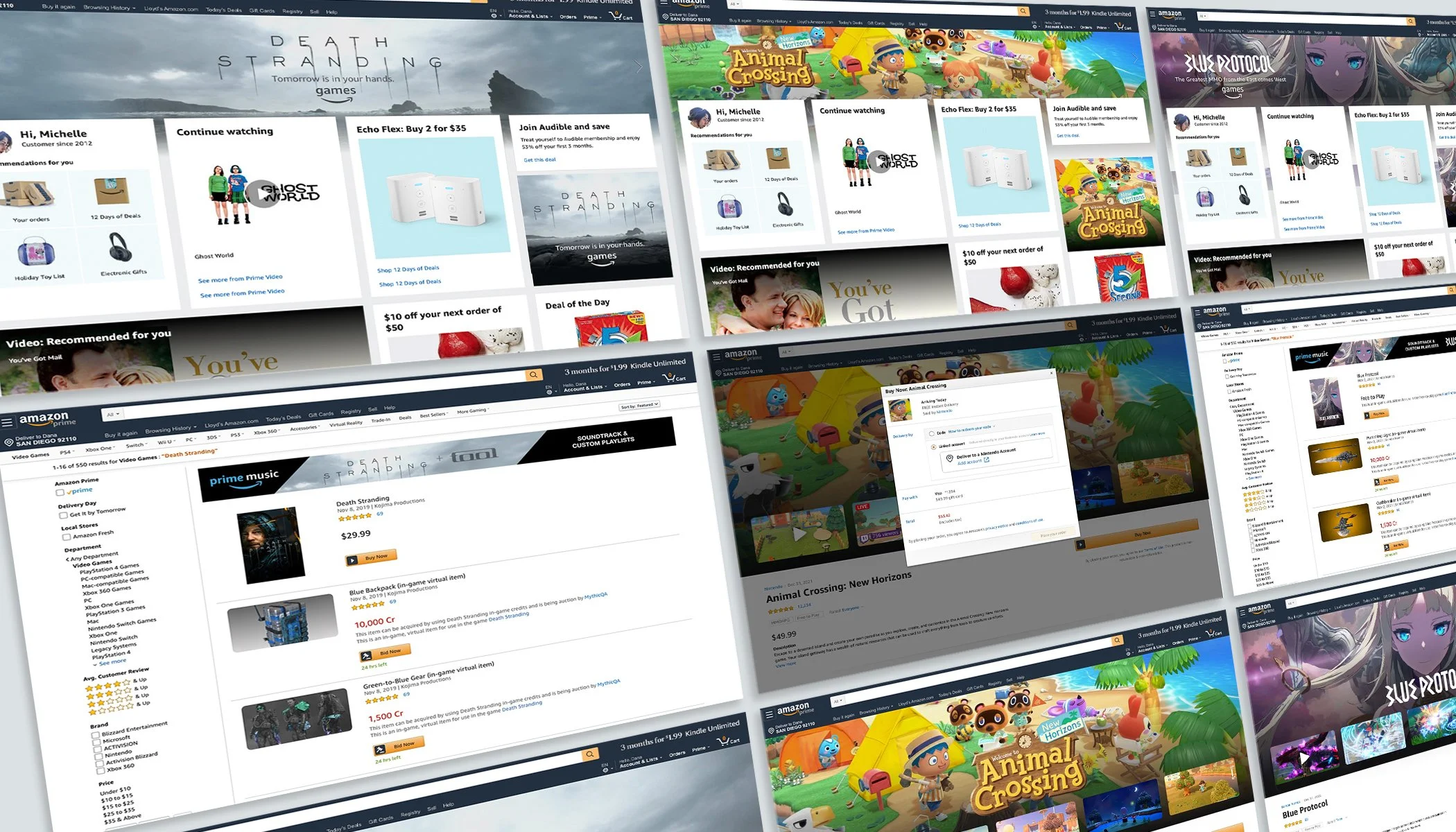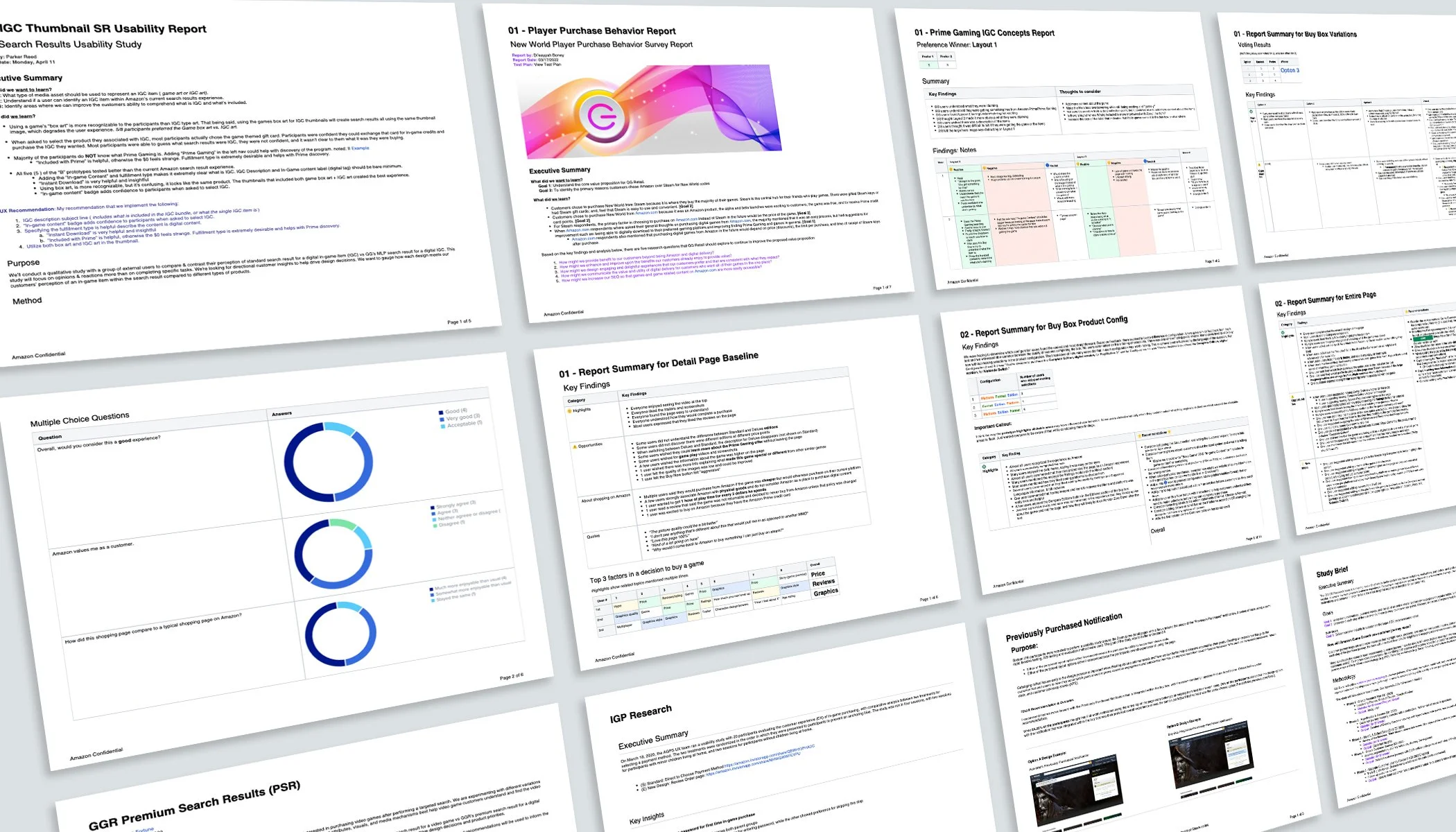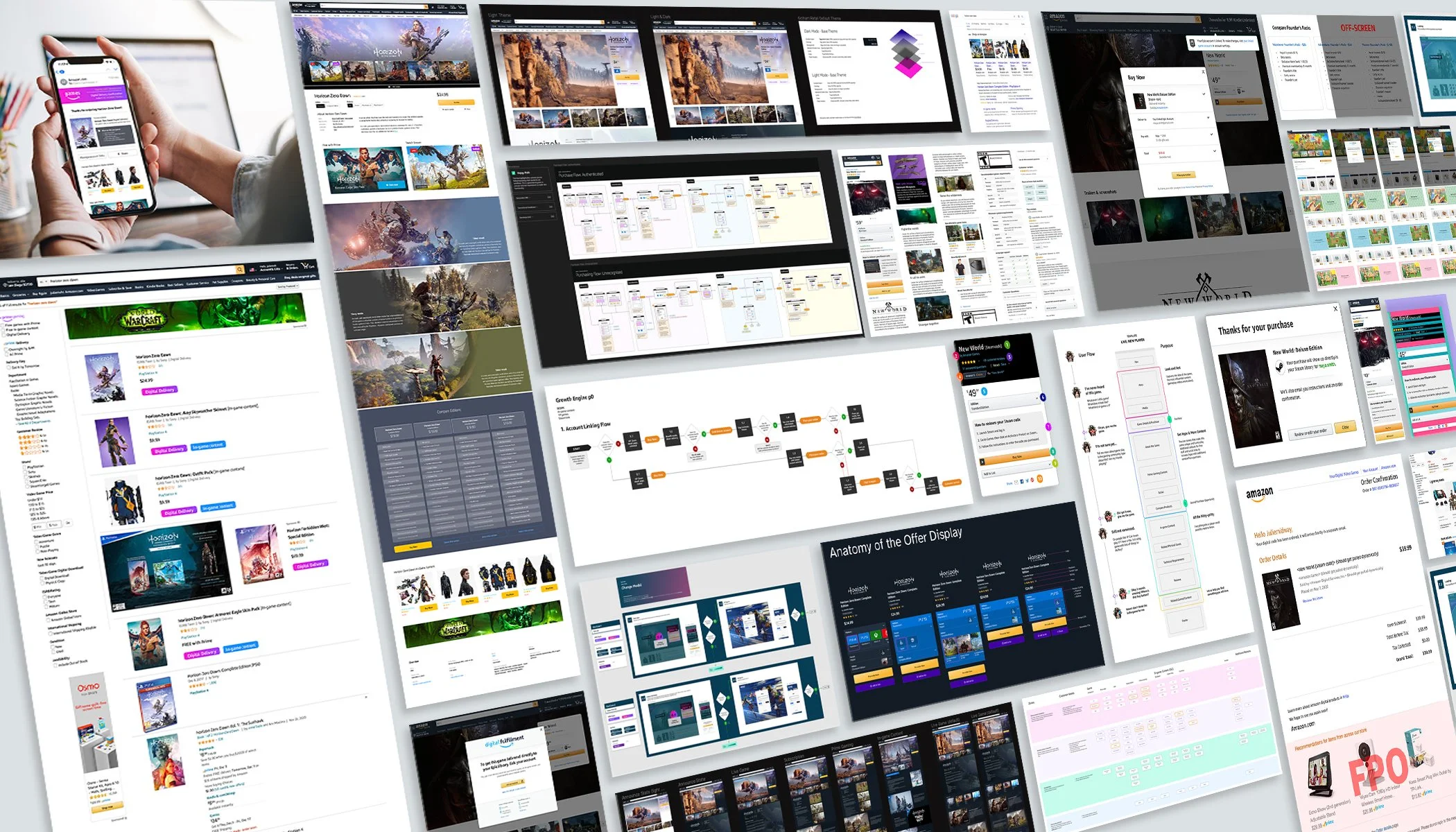
Amazon Game Growth / Retail
CASE STUDY
Buying digital games on Amazon.com
Amazon Game Growth is a team dedicated to amplifying 1st and 3rd party games discovery, engagement and monetization. In my role as Head of UX, I was a key stakeholder in the strategic direction of the organization, I built a centralized design team, delivered solutions for all of our core products, managed the organization’s rebrand, oversaw the development of a comprehensive design system, and managed internal and external partner and vendor relationships.
MY ROLE
Head of UX & Initial Design Lead
TOOLS
Figma, UserTesting.com, Photoshop, Qualtrics, Jira, Confluence
YEARS
2020-2023
The Problem
Buying games on Amazon is essentially the same as buying a shovel. Functionally sound, but largely inadequate when it comes to exciting a buyer and educating them on a game’s story, game-play dynamics, and style.
Additionally, Amazon’s retail solution is primarily focused on physical goods and delivery, and lacked a digital delivery solution that could deliver games and in-game content directly to a gamer’s game, device, and/or platform.
The Customers
Gamers: Game Growth focused on solving the needs of gamers, by building a media rich experience that would deliver digital games and game content directly to them.
Game Developers: Game Growth focused on building a digital content retail solution for game developers that could live outside of a developer’s own platform, while at the same time exposing their content to Amazon’s hundreds of millions of customers. Lastly, we wanted to give game developers the tools to properly tell the story of their game on Amazon retail.
Results and Learnings
Increased Conversion!
The new detail pages were wildly successful when it came to customer delight, and resulted in an increased conversion of over 200% vs. the same game on a standard Amazon retail page.
+200% Conversion
Discovery is Critical
While we significantly increased conversion, we learned that there were numerous discovery mechanisms owned by different teams within Amazon that required integration efforts that we hadn’t anticipated.
Scalability is Vital to Long-Term Success
Launching new pages took too long. Adding a new game page to Amazon retail could take months of effort. To rectify this we built new ingestion tools and a new design system that significantly sped up our ability to launch.
Months -> Days
How We Did It
The Process, kind of…
Normally we would have started a project like this by following a formal User Centered Design (UCD) process, but in this case it all started with an exploration done in my free time. My hunch was that we could significantly increase interest and conversion with a game-centric retail experience. After prototyping and sharing the solution with stakeholders we set about validating the hunch.
It all started with a blue-sky prototype
Various teams inside of Amazon had tried, but normally fell short of making experiences on Amazon retail that were truly tailored to the customer type associated with their product. In most cases this resulted in leveraging bits and pieces of the standard retail page tech and “Frankensteining” custom content modules into parts of the page. With an upcoming game launch on the horizon, I decided to have some fun and prototyped a blue-sky concept of what it might look like to have a fully customized, game-centered experience on Amazon.
Socializing the Idea
Sharing this prototype with folks on the team resulted in a fair amount of excitement and I was asked to explore ways in which we could actually build it. This led to me deconstructing the prototype and developing a system that would enable us to build elements modularly, each with their own set of customizable sub-components…giving us the flexibility to build and test a wide range of page layouts instead of being limited to a single, static template.
Validating with Amazon Customers
After presenting the idea to internal stakeholders and partner teams we began to sense there was real interest in building this type of solution for games. The next step was to run user testing to help validate it with Amazon customers. The results gave us the confidence that this solution would benefit the customer when it came to making a purchase decision and would likely increase conversion.
13 out of 13
All customers found the new solution more delightful and visually appealing
Standard Amazon pages are very functional, but lack visual appeal and/or delightful moments. Test participants were audibly impressed when introduced to the new pages.
"I mean, c'mon, how could you even compare them?...I see the evil, I see the battle, I see the potential in the first images on new page. On standard Amazon, I don't see any of that."
11 out of 13
The majority of customers found the new solution much easier to use
The new page focused almost entirely on the game, it’s features, and it’s play style, vs. standard Amazon pages that often inject carousels and widgets of related content throughout the page.
"The new page keeps the focus on the game rather than all this other junk that Amazon wants to stick on ya all the time."
11 out of 13
The majority of customers found the new solution better helped them make a purchasing decision
Gaming is a visual storytelling medium. Gamers expect to be able to quickly get a sense for what the game is like and the style of gameplay through images and video.
"If I want an adventure, I want everything on the page to be about having that adventure, not, 'Oh, do you wanna buy this other thing too?'"
Design Sprint with Stakeholders
Once we locked in and committed to the idea of building a custom retail solution for games, we decided to run a design sprint to hone the idea and tease out any new ideas that would make the experience even better.
💡
Direct digital delivery of digital content
One of the most exciting ideas that came out of the design sprint was the ability to deliver digital content directly to a customer’s gaming platform or device by linking their game account to their Amazon account.
💡
Integration of Prime Gaming content
Including Prime Gaming content with games was another idea that simply made too much sense to pass on.
💡
Integration of related Amazon services, such as Twitch, Prime Video, Amazon Music and more
With discovery being such a critical component to this solution we decided to explore ways in which we could cross-pollenate the games with related Amazon digital content such as Twitch, Prime Video, and Amazon Music.
Validating with Game Developers
Our next step was to get this idea in front of a host of game developers and confirm whether or not they saw as much value in the ideas as we thought they would. To do this I built a number of prototypes using publisher-specific IP while coordinating with our business development team to arrange meetings with those same publishers. I presented each prototype to a host of C-level executives, and in each case the response was overwhelmingly positive.
★★★★★
"This is what we’ve been hoping Amazon would build!"
★★★★★
"When can we have it?"
★★★★★
"This is THE Amazon!'"
★★★★★
"If we had this we might stop maintaining our own site."
★★★★★
"It’s great to see Amazon leveraging its strengths in this way."
The v1 Launch
Although we had soft-launched a version of our retail experience with one of Amazon’s first games (Crucible), I consider our first real launch to be the launch of Amazon’s massively multiplayer game New World.
Post Launch Testing
After launching the first version of our new retail pages we set out to test, iterate, and optimize the entire experience. This included studying the entire funnel from outside of Amazon, to discovery on Amazon, through to fulfillment and delivery of content.
Iteration
In addition to user testing, we cycled through hundreds of design ideas to optimize the user experience, solved for edge cases we hadn’t originally anticipated, and extended the feature set available to users and developers.
Building an Ingestion System
Scalability was a significant issue with the first version of our retail solution. Adding new pages could take months and modifying existing pages could take weeks. To rectify this we developed an ingestion system that removed the need to have engineers involved in every step of a page launch and reduced the time to launch a new page from months to days, and making changes from days down to hours .
Building a Design System
While the intent for v1 was to build it using a modular design system, the reality is that for the sake of speed it was all hard-coded, leaving it very inflexible and requiring an unsustainable amount of manual labor by engineers to add new pages or modify existing pages. To help rectify this we built a new design system from the ground up which significantly reduced design and development times moving forward and gave us much more flexibility when it came to ideation and testing.
The v2 Prototype
The v2 Prototype is currently in production and represents the culmination of years’ worth or work by hundreds of people, including designers, researchers, engineers, product managers, and more across several teams. It was developed using a custom design system built from the ground up to support vastly accelerated design and development cycles and includes a massive amount of improvements for both customers and game developers alike.


